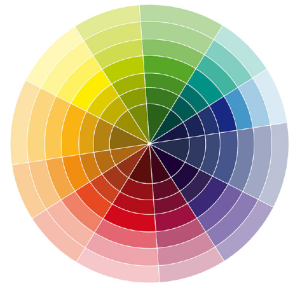Colour analysis is a very important part of my work as a personal shopper. It’s one of my essential tools. It’s used to determine what colours and tones best suit my clients according to their hair colour and skin tones.
Using these tones as your guide, you’ll see how the same shades of colour don’t work for everyone.
Each colour has its warm and cool shades (winter/summer), depending on the depth of blue or red in the composition and how they look. It may be the case for example, that a client will feel good in red, but will only suit the cool tones.
On this colour wheel below, you can see the primary colours – blue, red and yellow, the section with a range of colours created from different combinations of the primary colours and finally, the tertiary colours which are a mixture of the previous two groups.

Distinguish two types of combinations:
Supplementary colours – these are placed next to each other on the colour wheel and allow you to create very harmonious styling.
Complimentary colours – these are placed opposite each other on the wheel and allow you to create perfectly matching, dramatic looks.
Colour is a powerful means of communication. Different shades can convey a variety of feelings and even arouse feelings or moods. They are associated with collective thoughts and ideas and each culture recognises colours in a particular way.
Employees wearing particular colours can convey certain aspects of personality or reinforce attitudes. Certain colours can signify a special occasion for the person wearing them.
Depending on the hue, tone, brightness, colour purity and where it is worn, each chosen colour sends a subliminal message to the person wearing it. It also gives a message to people the wearer interacts with.
The upper body, from the waist up, is primarily concerned with the emotional body – our needs and wants. So garments worn here represent these aspects of people – blouses, shirts, sweatshirts, vests, scarfs etc.
The lower body, from the waist down, conveys information about the material and physical energy of the wearer – their strength when defending a position. Trousers and skirts represent these aspects.
Application of colours
Determining my client’s skin tone takes a little more work. I need to see her face without make up when it has been cleansed. It’s important that the light is natural.
See if the skin tends to look yellow, green or gold. If this is the case, it is a warm skin tone. If, instead, it tends towards pink, red or white, it is a cool tone. Another way to check is to see which blends better – gold goes with warm skin tones and silver goes with cool tones.
Once you’ve determined the skin tone you’ve made substantial progress towards excellent styling. Cool tones fall into winter or summer colour palettes, warm tones fall into the spring or autumn colour palettes. Next, we’ll go through the details of each colour palette.
Winter
If my clients skin is either pale as porcelain or an olive colour, the tone of her face will be pink or blue. ‘Winter’ clients often have dark hair and eyes. Asian people fall into this group, although some Scandinavians with blond or almost white hair also can.
The colours that work best with this type of skin tone are intense, rich colours such as black, navy, red and pink. White or light yellow can also work. Beige, orange or gold should be avoided.
Palette of winter colours:
Summer
As winter clients usually have dark hair, summer clients usually have blonde or light brown hair and blue eyes. Pale yellows, purples and mauves and pastel shades are the most suitable colours for these clients. In general, earth tones also work well. Orange doesn’t suit this sin type
Palette of summer colours:
Autumn
Autumn is a warm palette and these clients will have a golden skin tone. Many redheads and brunettes with brown eyes fall into this group. Some clients with golden skin tones can also have black or blonde hair. Earth tones usually work well, like caramel, beige, khaki, orange, gold and dark brown. Avoid black or white which will make these clients look tired. Avoid pastels too, they don’t flatter this tone.
Palette of autumn Colours
Spring
Clients with a Spring skin tone will have creamy, white or peach skin – very light shades. They can have golden blonde, auburn or strawberry blonde hair. Their eyes will usually be blue or green. Freckles and rosy cheeks are typical of this group. The difference between autumn and spring groups is often the eye colour, spring clients have lighter eye colours.
The most suitable colours are soft, like peach, golden yellow, golden brown, ivory, green and light blue. Some reds will also look great. Avoid dark and muted tones, like dark gray or black.
Palette of spring colours

Palettes to be added.
LikeLike
Get people reading this to participate by sending a selfie of their face then you have something to work on p
Sent from Samsung Mobile
LikeLiked by 1 person